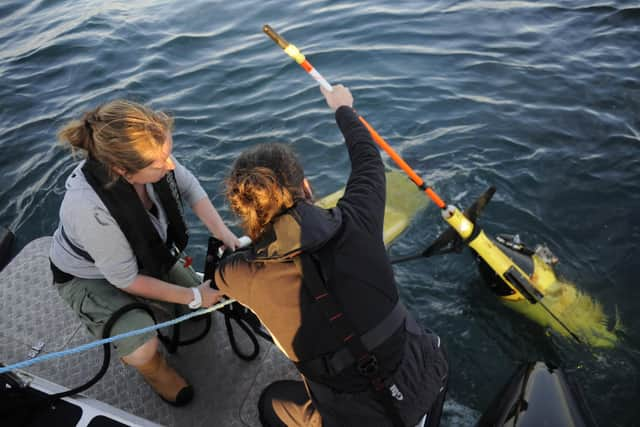How warm was the sea and what do hottest June and ‘extraordinary’ marine heatwave mean for the climate?
Provisional figures show the average mean temperature was of 15.8C, around 2.5C higher than usual and smashing the previous record of 14.9C by nearly 1C. All four nations have also individually experienced their warmest June since official monitoring began in 1884.
In total, 72 counties this year saw their hottest June since records began.
Advertisement
Hide AdAdvertisement
Hide AdMeteorologists have blamed climate change for the extreme heat, with research suggesting the chances of record-breaking June temperatures – like this year’s – had at least doubled in the past 80 years.
The month was also drier than customary, as well as sunnier.
At the same time the north Atlantic – including around the UK – experienced an unprecedented marine heatwave, with June water temperatures the highest ever recorded.
The phenomenon was first identified via satellite monitoring, which revealed ocean surface temperatures in June had reached around 5C above average for the time of year.


The readings prompted the US National Oceanic and Atmospheric Administration to categorise parts of the North Sea in a level four marine heatwave – considered “extreme”.
According to scientists, the warmer seas have played an underlying role in the high land-based temperatures.
Met Office scientific manager Segolene Bethou said: “These settled conditions also contributed to a fast warming of the sea surface around the British Isles: a severe marine heatwave was declared mid-June.


“Provisional findings from the Met Office suggest this marine heatwave in turn amplified land temperatures even further to the record levels seen during the month.”
Advertisement
Hide AdAdvertisement
Hide AdExperts have raised concerns that the excessive heat could kill off fish and other sea creatures around the UK, with mortalities already reported in rivers.
Scientists in the Highlands are conducting a deep dive into the causes and effects of the recent marine heatwave, which saw UK sea temperatures rise above 16C.
Oceanographers from the Scottish Association for Marine Science (Sams), based in Oban, have been analysing data gathered by subsea robot ‘gliders’ deployed in the north-east Atlantic to gain fresh insights into the “extreme” event.


Underwater readings have confirmed the record-breaking temperatures, but they have also revealed the “extraordinary” heat was confined to the top 20 metres of the ocean, with deeper water remaining closer to typical levels.
However, they fear this top layer of extremely warm water could have profound effects on ocean systems that influence the global climate.
“It’s like nothing we’ve seen before,” said Sams oceanographer Dr Neil Fraser.
“The peak sea surface temperature is the hottest on record and up to 5C warmer than the average for June.
“To put it into context, the seasonal sea surface temperature peak is not usually until August.”
Advertisement
Hide AdAdvertisement
Hide AdSams has operated autonomous gliders in the north-east Atlantic since 2010 but has had near continuous data collection for the past 10 years.
Over that time the mini subs have been on 29 missions, covering more than 40,000 miles between them.
The information gathered is providing new clues into warming events and filling in crucial data gaps.
Dr Fraser added: “Satellites are great at measuring the sea surface ‘skin’ over a large area and the shallowest fixed mooring sensors we have are about 50m depth, so gliders are really coming into their own.
“It’s like having a mobile thermometer in the ocean.
“Another advantage is the gliders can inform us of such heatwave events as they are happening. Over time they might also be able to tell us where this heat goes – will it mix into the ocean or will it be absorbed into the atmosphere?”
The scientists believe a shifting and weakening of the trade winds, which would normally cool the sea surface, could be behind the marine heatwave.
By examining the latest measurements in more detail, they aim to investigate the causes and the implications for the deeper ocean.
Sams gliders continually monitor the north-east Atlantic, where the exchange between the salty and relatively warm Atlantic water and the colder, fresher Arctic ocean plays a major role in the world’s climate.
Advertisement
Hide AdAdvertisement
Hide AdA large system of ocean currents, known as the Atlantic Meridional Overturning Circulation (AMOC), transports warm surface waters from the tropics northward towards the subpolar and Arctic regions.
There, the waters cool, become denser and sink before returning southward at depth.
This vast ‘conveyor belt’ movement of water is a major factor in controlling global heat distribution, regional sea level changes, the ocean’s absorption of carbon and European weather.
“While the AMOC is not likely to have been the driver of this recent heatwave, we are very interested to find out whether these extraordinary sea surface temperatures will have an effect on the system,” said fellow Sams oceanographer Prof Stuart Cunningham.
State of the Climate: Report shows UK is hotter, wetter, sunnier and sinking faster than ever before
“Often described as Europe’s central heating system, the AMOC relies on the water being much cooler in the global north.
“If the water is too warm, this can inhibit the dense water formation which drives the AMOC, and that could have profound effects on global climate and weather.”
Mark Owen, head of fisheries at the Angling Trust, warned that the hot weather had already killed thousands of fish across the country and there could be worse ahead. He said: “If July is like June, if August is like June, then we will get far more fish kills than we’ve ever seen. There is a knock-on effect.”
Comments
Want to join the conversation? Please or to comment on this article.